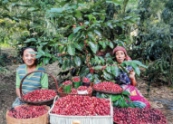3.3 Empowering Every Citizen: Through Financial Inclusion
The journey toward equitable economic growth hinges on the ability of all citizens to participate in and benefit from the nation’s progress. In this way, financial inclusion is not just an economic imperative; it is a pathway to social empowerment, poverty reduction, and sustainable development.
NABARD has consistently championed the cause of promoting microfinance, credit linkages, and financial literacy, particularly for women, farmers, and small entrepreneurs in its mission to provide every Indian, particularly those in rural areas, with access to formal financial services. By promoting the SHG-Bank Linkage Program (SBLP), NABARD has facilitated access to formal financial services for millions of women and marginalised communities. Similarly, Joint Liability Groups, promoted by NABARD, have been instrumental in extending credit to small farmers, tenant farmers, and landless agricultural labourers
While significant progress has
been made, challenges remain in
reaching the last mile, especially in
terms of financial literacy and the
digital divide in some rural regions.
Financial literacy and digital
literacy are essential tools for needy
people to access better livelihood
opportunities and benefit from
government welfare schemes.
3.3.1 Self Help Groups (SHGs)
NABARD has played a pivotal role in pioneering and scaling the SHG-Bank Linkage Program (SBLP) across India. By linking SHGs with formal banking institutions, NABARD has not only facilitated access to microcredit but has also fostered a culture of saving, financial discipline and collective responsibility. These small, community-based groups, often comprised of women have improved the socio-economic status of millions of rural families, promoting entrepreneurship, and contributing to overall rural development.
Financial inclusion of the poor especially women as on 31 March 2024
177.5 million
Estimated no. of families covered till 31 March 2024
14.42 million
Total no. of SHGs savings linked with banks as on 31 March 2024
83.51%
Out of total SHGs saving linked - exclusive Women SHGs
5.48 million
Total no. of SHGs credit linked during the 2023-24
97.04%
Out of total SHGs – credit linked exclusive Women SHGs
₹38.2 million
Average loan amount disbursed/SHG during 2023-24
₹33.5 million
Average loan amount outstanding/SHG as on as on 31 March 2024
3.3.2 Joint Liability Groups (JLGs)
NABARD’s innovative JLG model has enabled individuals who typically lack collateral or credit history to access loans through collective borrowing. By bringing together individuals into groups, NABARD’s JLG model fosters a system of mutual accountability and financial discipline. This innovative framework not only enhances access to credit for rural population but also strengthens their ability to invest in agriculture, small businesses, and income-generating activities, thereby improving their economic stability.

NABARD offers both technical and financial support to financial institutions aimed at establishing and developing Joint Liability Groups (JLGs), thus enabling the programmes to extend its reach to the most isolated regions. Additionally, NABARD assists JLG members in securing timely, collateral-free loans through formal banking systems and promotes income diversification by facilitating the growth of micro-enterprises in the non-agricultural sector. Furthermore, NABARD provides concessional refinance to the banks financing JLGs. Over the past five years, JLG accounts have grown at an impressive CAGR of 43.76%1, showcasing NABARD’s impact in strengthening rural credit systems. Together, SHGs and JLGs now cover more than 50% of Indian households, reaching 10% of the country’s population2, further solidifying NABARD’s pivotal role in transforming rural economies.
1Economic Survey 2023-24
2Economic Survey 2023-24
Promoting of JLG as on 31 March 2024
33.13 million
Number of JLGs promoted till 31 March 2024
7.33 million
Number of JLGs promoted during 2023-24
₹3.36 million
Cumulative Grant assistance to facilitate promotion of JLG
0.22 million
members of the successful JLGs have already benefited from various training and exposure visits
3.3.3 Expansion of Rural Banking Infrastructure
The Financial Inclusion Fund (FIF), managed by NABARD, is instrumental in facilitating efforts to provide banking and financial services to populations that are underserved or unbanked, especially in rural and remote regions. FIF promotes financial literacy, enhances banking infrastructure, and supports various initiatives, including village knowledge centres, micro-credit programmes, and digital financial solutions. Through its financial assistance, FIF aids in the development of banking infrastructure in these areas by funding the establishment of banking outlets, branchless banking options such as Business Correspondents (BCs), and village knowledge centres. To advance digital financial inclusion, FIF endorses the deployment of digital payment systems, mobile banking, and e-wallets in rural communities. By offering grants to institutions and organisation dedicated to these objectives, FIF ensures that marginalised groups have access to vital financial services, encompassing credit, savings, insurance, and remittance services.
Progress under FIF Amount (₹ Billion)

Stimulating demand and supply for financial inclusion infrastructure

- 381 RSETIs nationwide to benefit from the initiative of CAPEX support to RSETIs-RUDSETIs 2.0.
- 0.35 million individuals will be trained annually through RSETIs.
- 23 Kiosk outlets were established in unbanked villages in NER states.
- Over 97 VSAT devices in challenging terrains.
- Over 600 solar power unit/ UPS devices deployed.
- 55 banks have been benefiitted from implementation of Positive Pay System.




